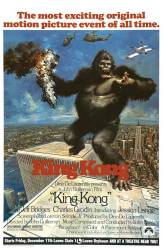Factual error: When the Petrox engineers dump Kong into the pit filled with chloroform they haven't knocked him out - they've killed him. Chloroform vapour is heavier than air so Kong is breathing it in a pretty pure form - and it is lethal in concentrations as low as 40,000 parts per million. In the time it would take to render a gorilla unconscious by this method, it would die. This ignores the fact that liquid chloroform is a severe irritant and a contact poison, and its breakdown products include phosgene and hydrogen chloride, both deadly poisons. They might as well save themselves some time and use that dinky little bulldozer to fill in the pit.
Factual error: The fact that the respiration of a single animal - however large - could lead to an increase in the level of carbon dioxide in the local area is so absurd it is laughable. Carbon dioxide exhalation is part of a closed loop cycle and the CO2 exhaled by Kong would be matched by the CO2 taken in by the plants growing on the island. It cannot be otherwise. Elevated levels of carbon dioxide are incredibly dangerous and any animal living on the island - including Kong - would suffer if things got out of kilter.
Factual error: How does Kong return a radar signal? If organic material is suddenly detectable by ship borne radar, why isn't it picking up the trees and other animals? Did someone invent gorilla-detecting radar?
Factual error: When Kong falls in the pit containing the chloroform and passes out, you can see some of the boat crew members walk into the chloroform cloud to look in the pit. Wouldn't they pass out also?
Factual error: When Kong breaks free in New York, he stomps on people, but not an inch of blood appears.






Answer: He probably knew it wasn't deep. It's his island; he knew every inch of it. Besides, it's a pool, not an ocean. It most likely had a small underground tunnel which spilled out somewhere on the island.